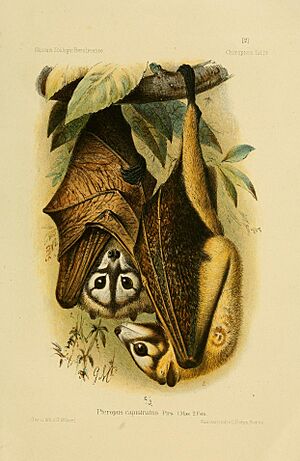Bismarck masked flying fox facts for kids
Quick facts for kids Bismarck masked flying fox |
|
|---|---|
 |
|
| Conservation status | |
| Scientific classification | |
| Genus: |
Pteropus
|
| Species: |
capistratus
|
 |
|
| Bismarck masked flying fox range (green — native, brown — vagrant) |
|
| Synonyms | |
|
|
The Bismarck masked flying fox (Pteropus capistratus) is a special kind of flying fox, which is a type of large bat. It belongs to the Pteropodidae family. These bats live in Papua New Guinea and are named after the Bismarck Archipelago, a group of islands nearby.
Scientists once thought this flying fox was a subspecies of another bat, the Temminck's flying fox. But in 2001, they decided it was its own unique species. There are two slightly different types, or subspecies, of the Bismarck masked flying fox: P. c. capistratus and P. c. ennisae.
Contents
Discovering the Bismarck Masked Flying Fox
The Bismarck masked flying fox was first officially described in 1867. A German scientist named Wilhelm Peters was the one who gave it its scientific name. For many years before 1995, most scientists thought this bat was just a subspecies of the Temminck's flying fox. But after more study, they realized it was different enough to be its own species.
What Does It Look Like?
The Bismarck masked flying fox is a medium-sized bat. One way scientists measure bats is by their forearm length. For this species, their forearm is usually about 109 to 118 millimeters long. That's about 4.3 to 4.6 inches, which is roughly the length of a small smartphone.
Amazing Bat Habits
These flying foxes have some very interesting habits! They are one of the few mammal species where the males can actually produce milk, just like females. This is very rare in the animal kingdom.
Most of the time, these bats prefer to live alone. They are generally solitary creatures. However, sometimes you might see a male and female roosting together in pairs. Roosting means resting or sleeping, often hanging upside down from trees.
Where Do They Live?
The Bismarck masked flying fox is found only in Papua New Guinea. This means it is endemic to that area and doesn't naturally live anywhere else in the world. They can live in many different places, from sea level all the way up to mountains 1,200 meters (about 3,900 feet) high.
Protecting This Unique Bat
As of 2021, the Bismarck masked flying fox is considered a vulnerable species by the IUCN. This means it is at risk of becoming endangered. The main reasons for this are that there aren't many of them left, probably fewer than 10,000 adult bats. Also, their homes are disappearing, and their numbers are going down. Protecting their habitat is very important to help these special bats survive.


